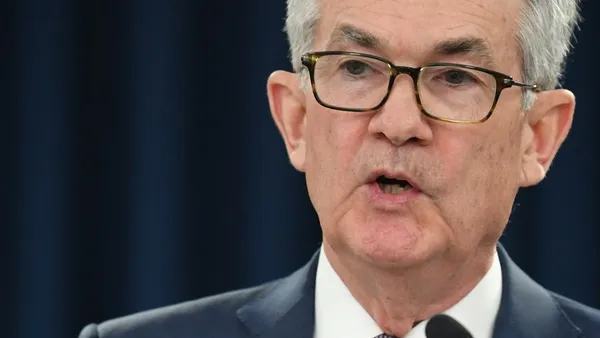Dive Brief:
- Federal Reserve Governor Randal Quarles, citing high inflation, said Thursday he would support speeding up a withdrawal of monetary stimulus at the next scheduled meeting of central bank policymakers on Dec. 14-15.
- Quarles spoke two days after Fed Chair Jerome Powell said in testimony to the Senate Banking Committee that the central bank may consider this month accelerating its tapering of monthly bond purchases, now on track to end in June.
- “I certainly will — given the data that we are seeing now — I certainly would be supportive of a committee decision to move the end of the taper forward from where people have been expecting it in June,” Quarles said during an American Enterprise Institute webcast. He said the Fed may need to use “other tools” for policy tightening if inflation in the spring still exceeds 4%.
Dive Insight:
Quarles and other Fed policymakers have said for much of 2021 that supply bottlenecks have temporality pushed up inflation to the highest level in three decades as the economy roars back from lockdowns and a severe, pandemic-induced downturn.
CFOs during the past several weeks have had to brush off the Fed’s assurances and adjust to signs that high inflation may persist well into 2022. Indeed, Powell said on Tuesday the central bank would do well to no longer refer to quickening inflation as “transitory.”
The consumer price index in October rose at a 6.2% annual rate, according to the Labor Department, well above the Fed’s long-run 2% target.
Also, CFOs have watched prices surge for the wholesale goods their companies use in production. The producer price index for final demand, a measure of what suppliers charge, soared 8.6% in October from the prior year, according to the Labor Department. That was a record jump in a series of data first published in 2010.
Inflation initially seemed fueled by transient and “anomalous” supply constraints, such as a shortage that pushed up prices for used cars, Quarles said. “There were reasons to say, ‘Ok, well you know, that’ll pass.’”
“This is not really solely, maybe not even primarily, a bottleneck story anymore,” he said. Instead, “we’ve got to increase productive capacity to meet that sustained higher level of demand — and that takes time.”
An extended period of 2.5% inflation would not pose a problem, Quarles said. But if the central bank ends its bond purchases in spring 2022 and inflation still persists above 4%, “the Fed would have to say, ‘Seriously, this has run too high for too long, we need to start using other tools.’”
The Fed last month began tapering by $15 billion its $120 billion in monthly bond purchases, putting the central bank on track to halt the policy of “quantitative easing” in June.
The Fed could end its bond buying by March — and clear the way for raising the benchmark interest rate — by trimming its purchases by $30 billion per month.















